its paid sponsors, whose products you need!
| Home |
| Intro |
| Current Issue |
|
Mailing List |
| Store |
| Strength |
| Subscriber Content |
| ARCHIVES
|
| Martialism |
| Pacifism |
| Q & A |
| Cunning-Hammery |
| Advertise With Us |
| Submit An Article |
| Staff |
| Discussion Forum |
| Links |
“Stay ‘unreasonable.’ If you
don’t like the solutions [available to you], come up with your
own.”
Dan Webre
The Martialist does not
constitute legal advice. It is for ENTERTAINMENT
PURPOSES ONLY.
Copyright © 2003-2004 Phil Elmore, all rights
reserved.
Looking Back at the Cold Steel Katana
By Phil Elmore
As I wrote in my review of the
Hanwei Practical Katana, I am not primarily a practicioner of the Japanese
sword arts. I do appreciate a fine sword, however, and I believe I
possess enough mechanics to use such a blade for expedient self-defense.
Apart from this, there is always a certain pleasure that comes with examining
a finely made weapon, particularly one with a sense of style. When I
first took delivery of a Cold Steel katana for evaluation in another
publication, I was pleased with the weapon.

The following is my account of the sword at that time,
before the first issue of The Martialist.
Cold Steels
website states that
their katana is hand forged. Individually heat-treated, tempered, and
polished, the 29-3/8 inch blade is of 1050 spring steel. A deep fuller runs
for most of its length. Weighing in at just under 40 ounces (without its
heavily lacquered wooden sheath), the sword is 40-3/4 inches overall. The
katana also comes with a very nice, heavy cloth bag.
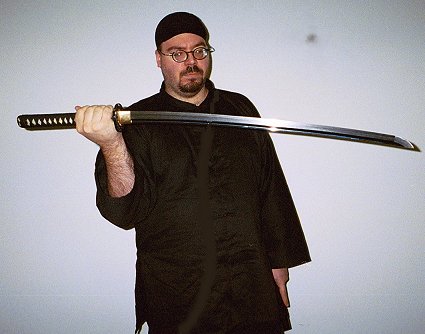
These statistics dont do the sword justice, however. When I took the sword
out of its box, I stared at it for a good five minutes, just holding it in my
hand. Now, keep in mind that this is, essentially, a production sword a
using sword with a suggested retail price of a little more than $800 USD at
the time of this writing. It will not match more traditional blades with price
tags of twice that much and there are, arguably, swords that are as nice
that cost less. As a production sword attainable by a wide audience of
would-be swashbucklers, however, this is a nice piece, particularly where the
attention to detail is concerned.

The black iron guard and pommel are
nicely wrought and visually quite appealing. My sample does show some rough
spots from the production process, but nothing too unusual. The pommel and
collar are textured.
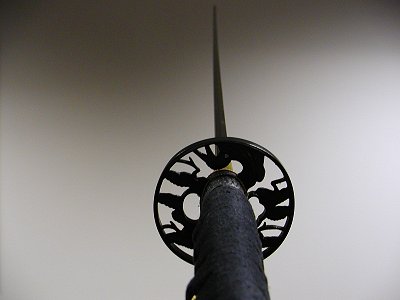
The rayskin covering the hilt is deeply pebbled and immediately
distinguishable from the plastic imitations one sees on some blades. The
handle wrap is nicely done and provides a very comfortable grip. I think it
could, perhaps, be tighter, but thats speculation on my part. The pegs
securing the handle are of wood, not plastic as found on lesser swords. The
black metal and brass furniture beneath the wrap is very attractive.
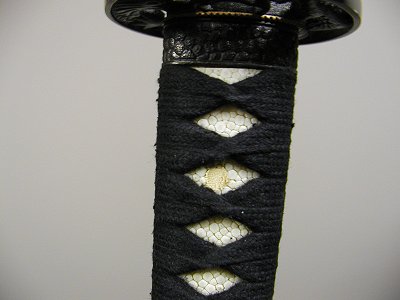
The hand-made blade collar is polished brass. It fits snugly in the very nice,
smoothly finished sheath. (The lacquer on the sheath is so thick that I at
first thought it might be aluminum before I looked inside.) An information
sheet included with the sword cautions the owner not to slam the sword into
and out of the sheath, as this will loosen the fit.
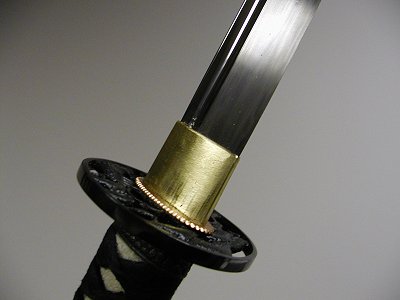
One of my martial arts instructors, who examined the sword with me, mentioned
that it flexed too much for his tastes. I think this is a matter of
preference. I own a shorter, straight-bladed custom sword that does not flex
as much, but I think the Cold Steel katana shows a healthy amount of spring in
keeping with its function. It returns to its original shape each time.
My instructor and another student also commented that the sword seemed a bit
heavy for them. I did not find it so, but I am large and not exactly
a… subtle… person, so heavier blades do not trouble me.
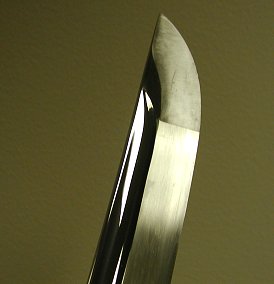
The sword handles well. It cuts the air with an audible zing! This took me
by surprise the firs time, as I wasnt trying to cut with real speed when I
tried it out. This sensation quickly becomes addictive. Furniture and low
ceilings tend to suffer as a result.
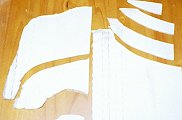 The
The
katanas point of balance is about seven inches above the guard. Given its
length, it is quite obviously designed for someone around six feet tall. It
was a comfortable length for me, for example, but too long for my instructor.
No sword can fit all people of all sizes, so be mindful of this when you shop
for one.
While the Cold Steel website states that the katana can sever 7 inch thick
bamboo with a single stroke, I tested it on much less demanding material.
Digging into my supply of helpless cardboard boxes, I slashed at one of them
again and again. The katanas properly sharpened, concave edge carved arc
after arc out of the material.
The challenge before Cold Steel will be to manufacture sword after sword to
the same standards of quality no easy task where blades of this kind are
concerned. If you have the opportunity to examine a Cold Steel katana and hope
to explore the art of the Japanese sword, I suggest you take the time to do
so.
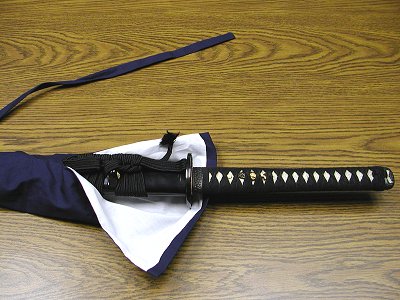
Since the first version of this article, Cold Steel has
introduced a line of functional swords with less expensive furniture intended
to compete with other no-frills “using” swords on the market. Any of
these might be suitable for the interested martialist, but there’s something
about the look and feel of this particular katana that made me sad about
giving it up when testing was complete.
I may yet add a Cold Steel katana to my personal armory.
